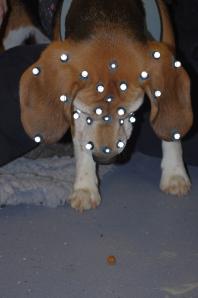Emotions and ear expressions

The involvement of neurological mechanisms in the occurrence of all emotion activation processes has led to the study of hemispheric specialization as a way to assess emotions both in humans and animals. The right hemisphere hypothesis has been used in both humans and primates to assess emotions of different valence. It suggests that the right hemisphere process intense emotions, which are displayed on the left side of the body. The right hemisphere is also dominant in processing emotional facial expressions and therefore facial expressions with emotional values are expressed more intensively on the left side of the face.
Measuring facial expressions in animals often take ear expression into account. Charles Darwin for example studied ear expressions in dogs in order to determine their emotions. Ear expression has also been used as a main characteristic along with other facial features when studying and comparing behaviour in canids. Nowadays, ear expression seems to be a valuable source of information when analysing dog behaviour. Although facial and ear expressions are of importance in social communication as well as for interpreting dogs’ intentions, few studies have focused on ear expressions. An attempt to investigate facial and ear expressions more thoroughly was made in beagles. However, since the technique used did not allow studying subtle changes in facial region more closely, there is still need for more detailed analysis of facial and ear expressions.
Responsible for this page:
Director of undergraduate studies Biology
Last updated:
05/15/13
